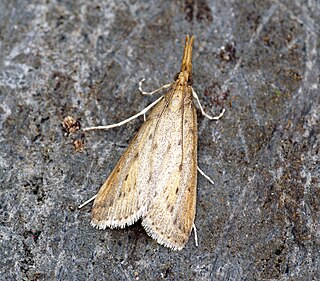
Schoenobius is a genus of moths of the family Crambidae and typical of the subfamily Schoenobiinae. Species are found mostly in Europe.

Scirpophaga is a genus of moths of the family Crambidae described by Georg Friedrich Treitschke in 1832. Asian species include significant rice stemborer pests.
Stenocalama is a monotypic moth genus of the family Crambidae described by George Hampson in 1919. Its only species, Stenocalama ochrotis, described by the same author in the same year, is found in Uganda.
Thiallela is a genus of snout moths. It was described by Francis Walker in 1863.

Schoenobiinae is a subfamily of the lepidopteran family Crambidae. The subfamily was described by Philogène Auguste Joseph Duponchel in 1846.
Prionapteryx albicostalis is a moth in the family Crambidae. It was described by George Hampson in 1919. It is found in what was Madras State in India.
Surattha diffusilinea is a moth in the family Crambidae. It was described by George Hampson in 1919. It is found in Australia, where it has been recorded from New South Wales.
Styphlolepis leucosticta is a moth in the family Crambidae. It was described by George Hampson in 1919. It is found in Australia, where it has been recorded from Western Australia.
Schoenobius endochalybella is a moth in the family Crambidae. It was described by George Hampson in 1896. It is found in Paraná, Brazil.
Schoenobius immeritalis is a moth in the family Crambidae. It was described by Francis Walker in 1859. It is found in Sri Lanka and Fujian, China.
Schoenobius irrorata is a moth in the family Crambidae. It was described by George Hampson in 1919. It is found in Paraná, Brazil.
Schoenobius pyraustalis is a moth in the family Crambidae. It was described by George Hampson in 1919. It is found in Argentina.
Schoenobius retractalis is a moth in the family Crambidae. It was described by George Hampson in 1919. It is found in Guyana.
Schoenobius sagitella is a moth in the family Crambidae. It was described by George Hampson in 1896. It is found in Brazil.
Schoenobius vittatalis is a moth in the family Crambidae. It was described by George Hampson in 1919. It is found in São Paulo in Brazil and in Paraguay.
Patissa rufitinctalis is a moth in the family Crambidae. It was described by George Hampson in 1919. It is found in Sierra Leone.
Cynaeda leucopsumis is a moth in the family Crambidae. It was described by George Hampson in 1919. It is found in Assam, India.
Azochis rufidiscalis is a moth in the family Crambidae. It was described by George Hampson in 1904. It is found in the Bahamas, Hispaniola, Puerto Rico, Cuba and the south-eastern United States, where it has been recorded from Florida.
Syllepte chalybifascia is a moth in the family Crambidae. It was described by George Hampson in 1896. It is found in India (Nagas).


